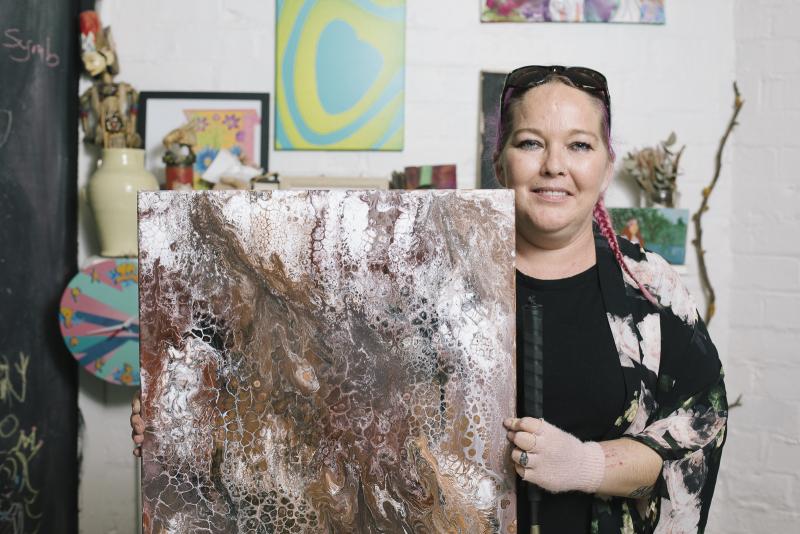
I’m a proud Kamilaroi woman who feels honoured to live on Wiradjuri land. My art has always been a meaningful part of my life, but I’ve only come to realise how integral it is to my identity and wellbeing since my world was turned upside down by a health issue that took its toll on my mental health.
Just three years ago, I was working full time and feeling fulfilled taking care of my family while volunteering with charities for suicide prevention and mental health awareness. At the end of a busy day I loved turning my hand to baking and painting. Everything that gave me a sense of involvement and belonging was suddenly disrupted when it became challenging for me to view the computer screen at work. I consulted an optometrist about a slight twitch in my left eye and over the course of a week, my sight worsened.
It was a shock to wake one morning with blindness in my left eye. I was admitted to hospital, where I remained for months after being diagnosed with an immune disorder called Sarcoidosis which had affected my lungs and eyes. Sliding into depression, I withdrew into my shell and hid myself away in my room for weeks at a time.
I didn’t want to be here anymore. Hearing my kids, knowing that one day I may not be able to see them at all, seemed too painful to bear. Every day began to feel like just another 24 hours to endure and I go to sleep each night in fear that tomorrow might be the day I wake to complete blindness.
During lockdown, I experienced a bit of a meltdown and sought the support of a psychologist, who suggested art therapy. I was resistant at first to the idea of having a support worker of any kind, because Young is a small town where everyone knows one another and I didn’t want to feel judged. However, after exploring a few options, I immediately felt comfortable with Flourish Australia’s person-led approach. With their encouragement, I set about improving my outlook.
It took me two weeks to build up the courage to pick up a canvas. It felt too confronting to try something I used to love doing, knowing I no longer had the same capabilities. When my husband encouraged me to give it a go and the result was amazing, it gave me motivation to keep going. I wanted to put a bit of me into each artwork so I used my white cane to achieve a particular effect with the paint.
The real turning point in my recovery came when I agreed to join a field trip with Flourish Australia’s photography group and explain the significance of sacred sites they visited for inspiration. It hit me how isolated I’d become, from not only my community but my culture, as I walked through hip-high wild grass and felt a powerful sense of peace and calm for the first time in years. Without realising it, I’d been bringing the colours of the land into my paintings and now that thread of belonging is consciously woven through my artistic expression in a bold new way.
Something unseen, deep inside me, has always been calling me back to where I belong.
I’m trialling a new technique where I paint, guided by touch, using my bare hands and objects found on country, like pieces of rope which I twist and curl to create a textural element. My painting now is created to be tactile and sensory in ways that can be appreciated by everyone, including people with vision impairment. I’ve found that working on really big canvases is helpful and I’ve found special devices that assist with the painting process.
My latest work attracted the interest of the local art society and I was asked to exhibit for Naidoc week. It meant a great deal to me, to be involved and I’m proud to say my artwork was displayed across one whole corner of the gallery.
A lot of my painting is done from memory these days and inspired by my lived experience. I paint beach landscapes a lot because that’s something I hope to see more of while I still have my sight. I’ve created artwork around masks that reflect the different emotions people feel, but don’t show, and I’m working on interactive pieces that depict different eye conditions, so you can look through the lens of someone with glaucoma or cataracts and understand what it’s like from their perspective. It’s a way of processing my own emotions and building inclusivity in community.
Blindness won’t change the fact that I have images in my head that I want to put out there. As my portfolio of work grows, so does my confidence that my life can still be fulfilling. It gave me hope for good things to come when the local Mayor admired my work, and the Director of the Art Society commented that he can see I paint boldly, from the heart, without overthinking it. It feels good to be valued by the communities I belong to.
You can enjoy my artwork on Facebook @blindeyecreations, ‘vision impaired art with heart’.
Talk to us today
For more information, contact us on 1300 779 270 or make an enquiry now.


